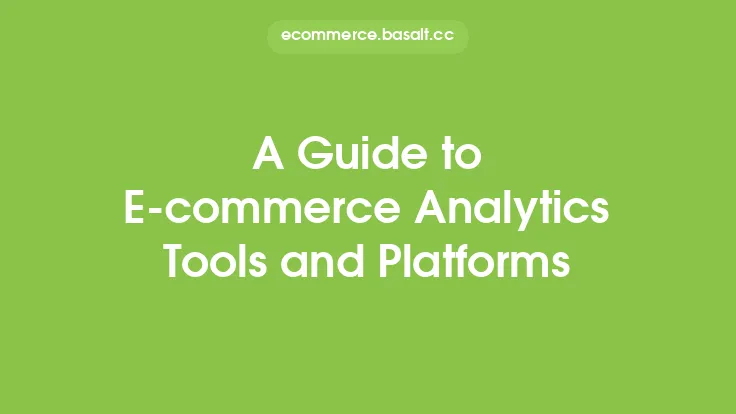In the world of e-commerce, data is king. With the vast amount of information available, online retailers can gain valuable insights into their customers' behavior, preferences, and shopping habits. By leveraging analytics, e-commerce businesses can make informed decisions, optimize their operations, and drive growth. In this article, we will explore the importance of analytics in e-commerce and provide guidance on how to use data to improve and grow an online store.
Introduction to E-commerce Analytics
E-commerce analytics refers to the process of collecting, analyzing, and interpreting data related to online store performance. This data can come from various sources, including website traffic, sales, customer interactions, and marketing campaigns. By analyzing this data, e-commerce businesses can identify trends, patterns, and areas for improvement. E-commerce analytics can be divided into two main categories: descriptive analytics and predictive analytics. Descriptive analytics focuses on historical data, providing insights into what has happened, while predictive analytics uses statistical models and machine learning algorithms to forecast what may happen in the future.
Benefits of E-commerce Analytics
The benefits of e-commerce analytics are numerous. By leveraging data, online retailers can gain a competitive edge, improve customer satisfaction, and increase revenue. Some of the key benefits of e-commerce analytics include:
- Improved decision-making: Data-driven decisions are more informed and less prone to bias.
- Enhanced customer experience: Analytics can help identify areas for improvement, such as website usability and customer support.
- Increased efficiency: Automation and optimization of processes can lead to cost savings and improved productivity.
- Better marketing: Analytics can help identify effective marketing channels and campaigns, allowing for more targeted and efficient marketing efforts.
- Competitive advantage: Businesses that leverage analytics are more likely to stay ahead of the competition.
Types of E-commerce Analytics
There are several types of e-commerce analytics, each providing unique insights and benefits. Some of the most common types of e-commerce analytics include:
- Web analytics: Focuses on website traffic, behavior, and conversion rates.
- Social media analytics: Examines social media engagement, sentiment, and campaign performance.
- Customer analytics: Provides insights into customer behavior, preferences, and loyalty.
- Marketing analytics: Analyzes the effectiveness of marketing campaigns and channels.
- Operational analytics: Focuses on supply chain, inventory, and logistics performance.
E-commerce Analytics Tools and Technologies
There are numerous e-commerce analytics tools and technologies available, ranging from basic to advanced. Some of the most popular tools include:
- Google Analytics: A web analytics platform that provides insights into website traffic and behavior.
- Adobe Analytics: A comprehensive analytics platform that offers advanced features and integrations.
- Salesforce Commerce Cloud: A cloud-based e-commerce platform that provides built-in analytics and insights.
- Tableau: A data visualization platform that helps businesses to connect, analyze, and share data.
- BigQuery: A cloud-based data warehouse that allows businesses to store, process, and analyze large datasets.
Best Practices for E-commerce Analytics
To get the most out of e-commerce analytics, businesses should follow best practices, such as:
- Setting clear goals and objectives: Define what you want to achieve with analytics and track progress.
- Collecting and integrating data: Combine data from various sources to get a comprehensive view of your business.
- Using data visualization: Present data in a clear and concise manner to facilitate understanding and decision-making.
- Continuously monitoring and analyzing data: Stay up-to-date with the latest trends and insights to make informed decisions.
- Taking action on insights: Use data-driven insights to drive change and improvement in your business.
Common Challenges in E-commerce Analytics
Despite the benefits of e-commerce analytics, there are common challenges that businesses may face. Some of the most common challenges include:
- Data quality and accuracy: Ensuring that data is accurate, complete, and consistent.
- Data integration and silos: Combining data from various sources and breaking down silos.
- Lack of resources and expertise: Having the necessary skills and resources to collect, analyze, and interpret data.
- Data overload and complexity: Managing and making sense of large amounts of data.
- Security and privacy: Ensuring that data is secure and protected.
Future of E-commerce Analytics
The future of e-commerce analytics is exciting and rapidly evolving. Some of the trends and technologies that are expected to shape the future of e-commerce analytics include:
- Artificial intelligence and machine learning: Using AI and ML to analyze data, predict behavior, and automate decision-making.
- Internet of Things (IoT): Integrating data from IoT devices to gain insights into customer behavior and preferences.
- Cloud computing: Storing, processing, and analyzing large datasets in the cloud.
- Real-time analytics: Analyzing data in real-time to facilitate faster decision-making and response.
- Personalization and recommendations: Using data to provide personalized experiences and recommendations to customers.
Conclusion
E-commerce analytics is a powerful tool that can help online retailers to drive growth, improve customer satisfaction, and gain a competitive edge. By leveraging data and analytics, businesses can make informed decisions, optimize their operations, and stay ahead of the competition. Whether you are just starting out or looking to take your e-commerce business to the next level, analytics is an essential component of any successful online retail strategy. By following best practices, using the right tools and technologies, and staying up-to-date with the latest trends and developments, you can unlock the full potential of e-commerce analytics and achieve long-term success.





